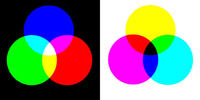One, three primary colors and three basic colors:
1, for light: trichromatic and three primary colors are the same thing: red (Red), green (Green), blue (Blue) - RGB;
2, for pigments: Generally speaking only three primary colors. The three primary colors of raw materials refer to red Huang Lan (pin Magenta, Huang Yellow, Qing Cyan - MYC).
3, therefore, the three primary colors of light are different from the three primary colors of raw materials. Because the optical color is different from the color principle of the printed color, the color range (color gamut) that they express is also different. Generally, the optical color gamut contains the printed color gamut. This is why the color of printed matter is sometimes unable to reach the color displayed on the monitor or TV. The three primary colors of printing are green, fine and yellow - CMY. Cyan is generally referred to as sky blue, and Pin Hong is generally referred to as magenta and rose red. Therefore, the workers in the early printing plant are usually called blue and red. As a result, the printing tricolor is the cause of red, yellow, blue and tricolor, which is confused with the optical red green blue.

Two, tricolor
1, three primary colors: composed of three basic primal colors. Primary colors refer to the "basic colors" that can not be obtained by blending other colors. Mixing the primary colors in different proportions can produce other new colors. Using the vector space of mathematics to explain the color system, the primary color can be used as a set of base vectors in the space, and can combine a "color space". Because the human eye has three different colors of the photosensitive, the color space is usually expressed by three basic colors, the three colors are called "tricolor". Generally speaking, the superimposed three primary colors are red, green and blue, while the subtractive primary colors are magenta, yellow and cyan.
Primary colors, also called basic colors, are the basic colors used to allocate other colors. The purity of primary colors is the highest, the most pure and the brightest. Most of the colors can be allocated, while other colors can not be configured with three primary colors.
The corresponding wavelengths of 2, three primary colors red, green and blue are 700nm, 546.1nm and 435.8nm respectively.
3. In the red, yellow and blue colors of art, fuchsin and a small amount of yellow can be made out of red (red =M100+Y100), but big red can not be made of fuchsin; green and a small number of fuchsin can get blue (blue =C100+M100), but blue and green are not bright green; yellow, magenta and green can be used to match more colors. And pure and bright. Green (green =Y100+C100) made with yellow and yellow is more pure and brightly than blue and yellow, while the latter is more gloomy; the purple of fuchsin and green is very pure (purple =C20+M80), while big red and blue can only get grey purple and so on. In addition, from the perspective of other colors, yellow, magenta, and green are the primary colors, which are more colorful and brightly coloured.
Whether it is from the definition of the original color, or by the results of the actual application, it is sufficient to show that yellow, fuchsin and green are called three primary colors, and red, yellow and blue are more appropriate for the three primary colors.
Three, basic color batching table (Art)
Red + yellow = orange
Yellow + blue = green
Red + blue = Purple
Red + Green = Brown
Red + Yellow + white = skin color
Fuchsin + Yellow + group green = black
Red + Green + blue = white
Four, the addition and subtraction of the original color
When the primary colors are mixed in different proportions, they will produce other colors. In different color space systems, there are different combinations of primary colors. It can be divided into two systems: "superposition" and "subtraction".
1, color three primary colors -- principle of color adding
Human eyes recognize colors according to the wavelength of the light they see. Most of the colors in the visible spectrum can be mixed by three basic colors in different proportions. The three basic colors are red (Red), green (Green), and blue (Blue). The three kinds of light are mixed in the same proportion and reach a certain intensity. They present white (white light); if the intensity of the three kinds of light is zero, it is black (Hei An). This is the principle of additive method. The principle of additive method is widely used in active lighting products such as televisions and monitors.
2, pigment tricolor - principle of color reduction
In printing, printing, painting, painting and other reflections on the surface of the media on the occasion of passive luminescence, the color of the object is the remaining part after the absorption of the pigment in the light source, so the principle of its color is called the principle of the color reduction method. The principle of subtractive method is widely used in various passive lighting occasions. The three primary colors in the subtraction principle are green (Cyan), magenta (Magenta) and yellow (Yellow).
3, tricolor color matching table































